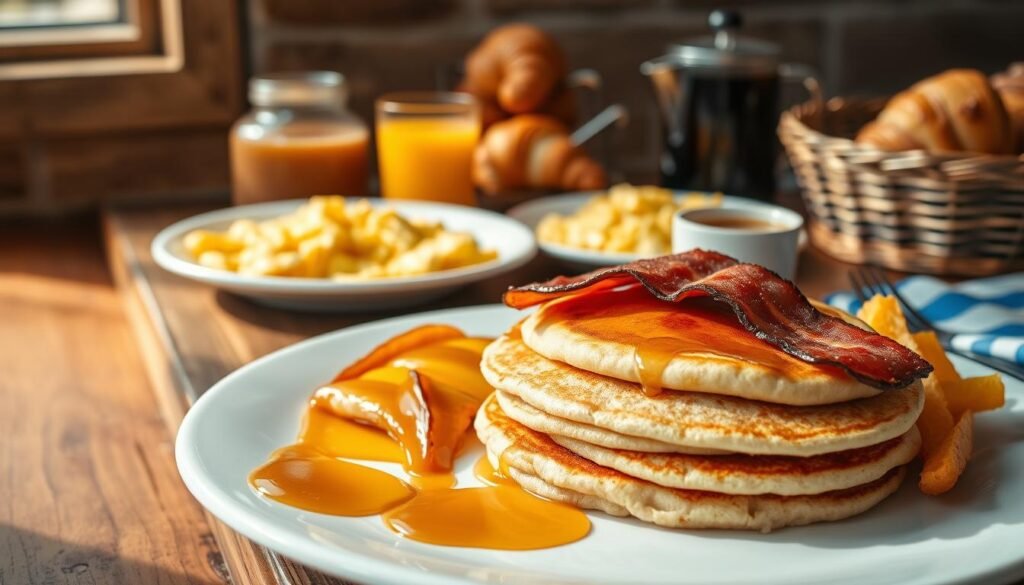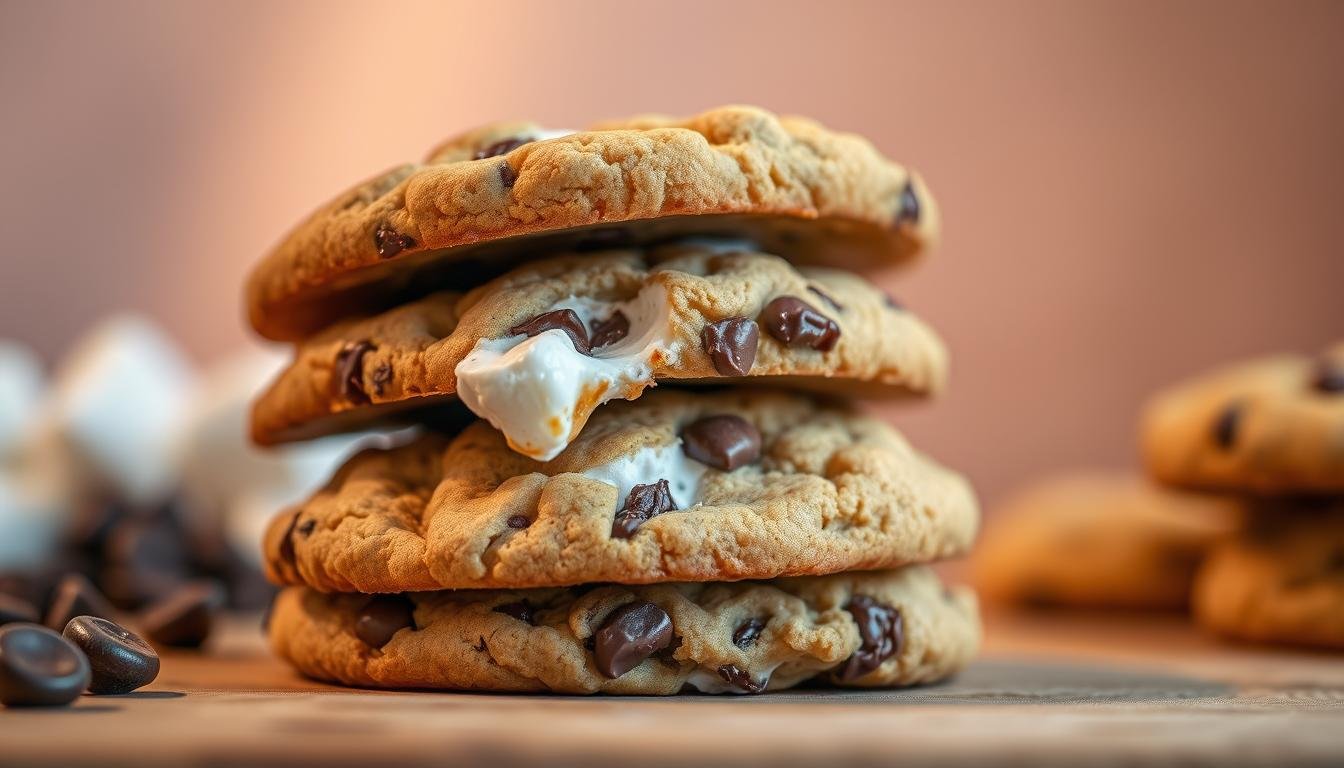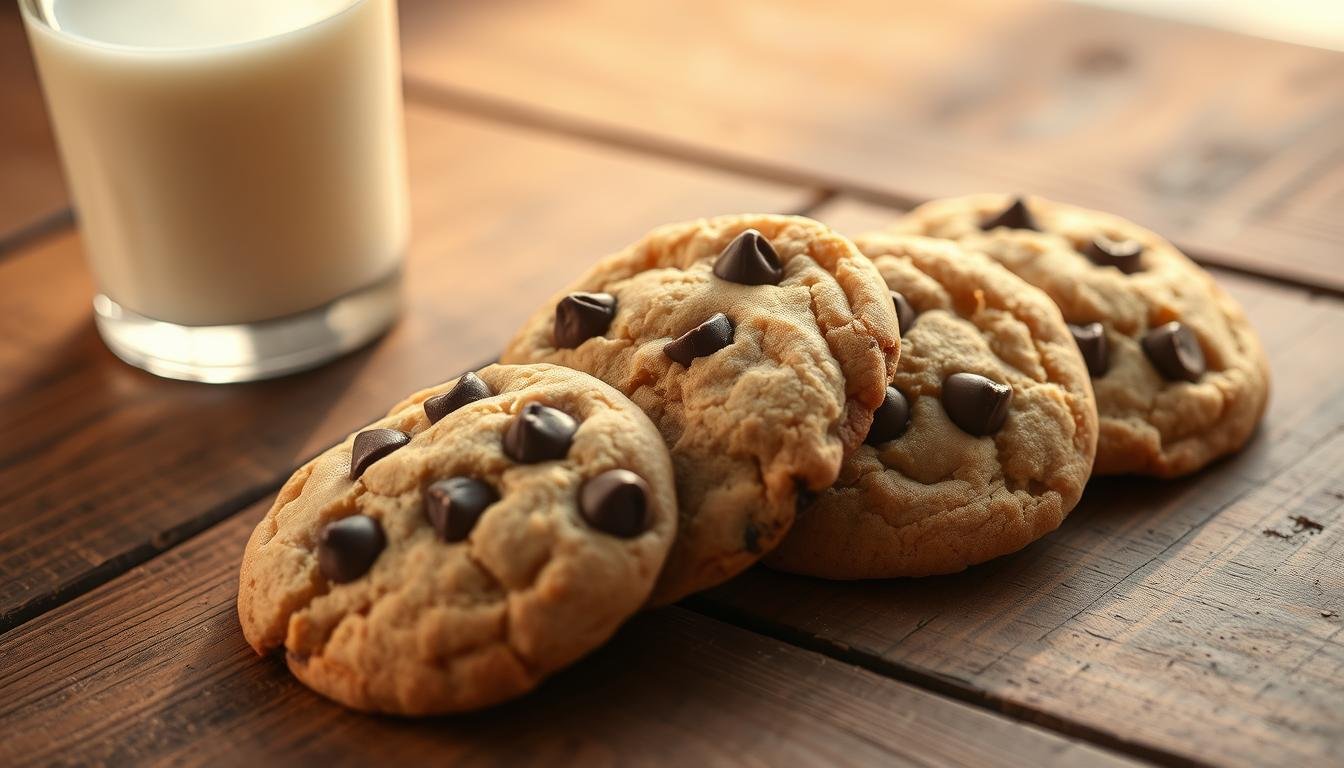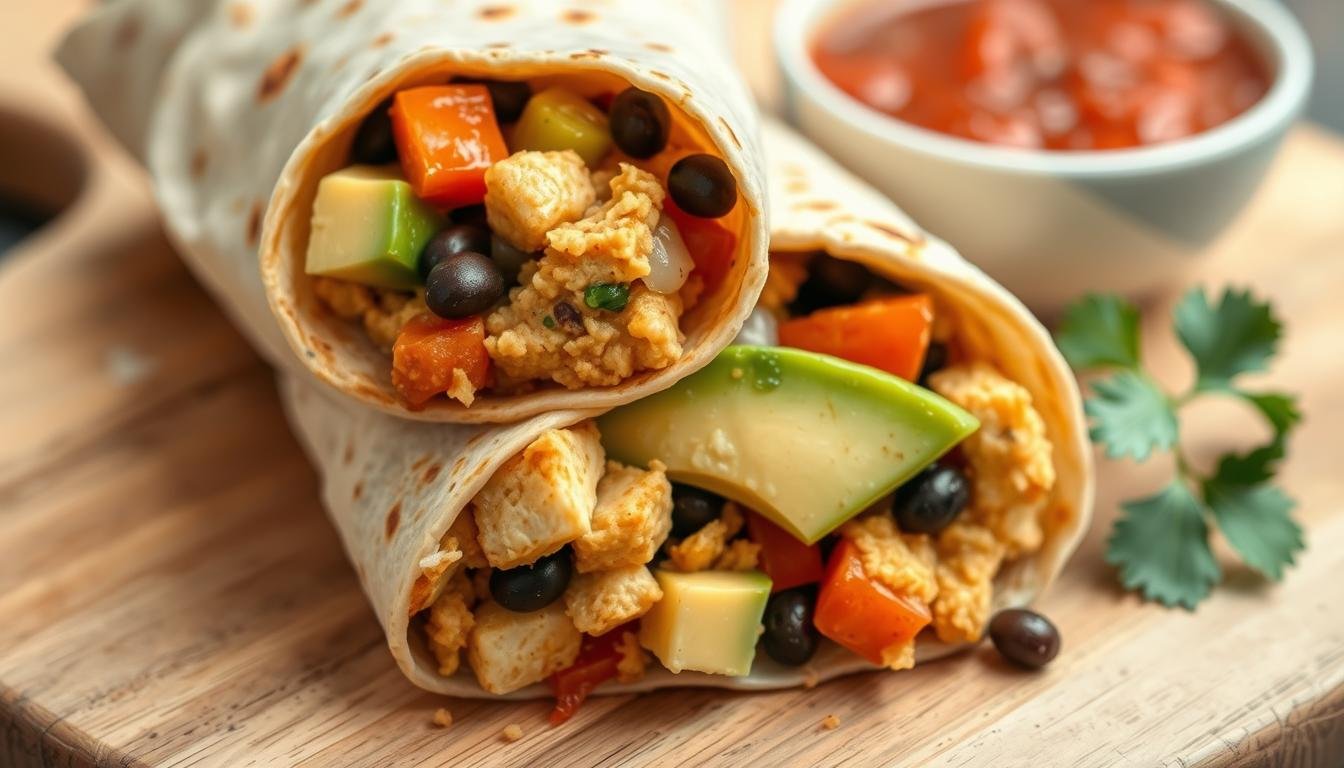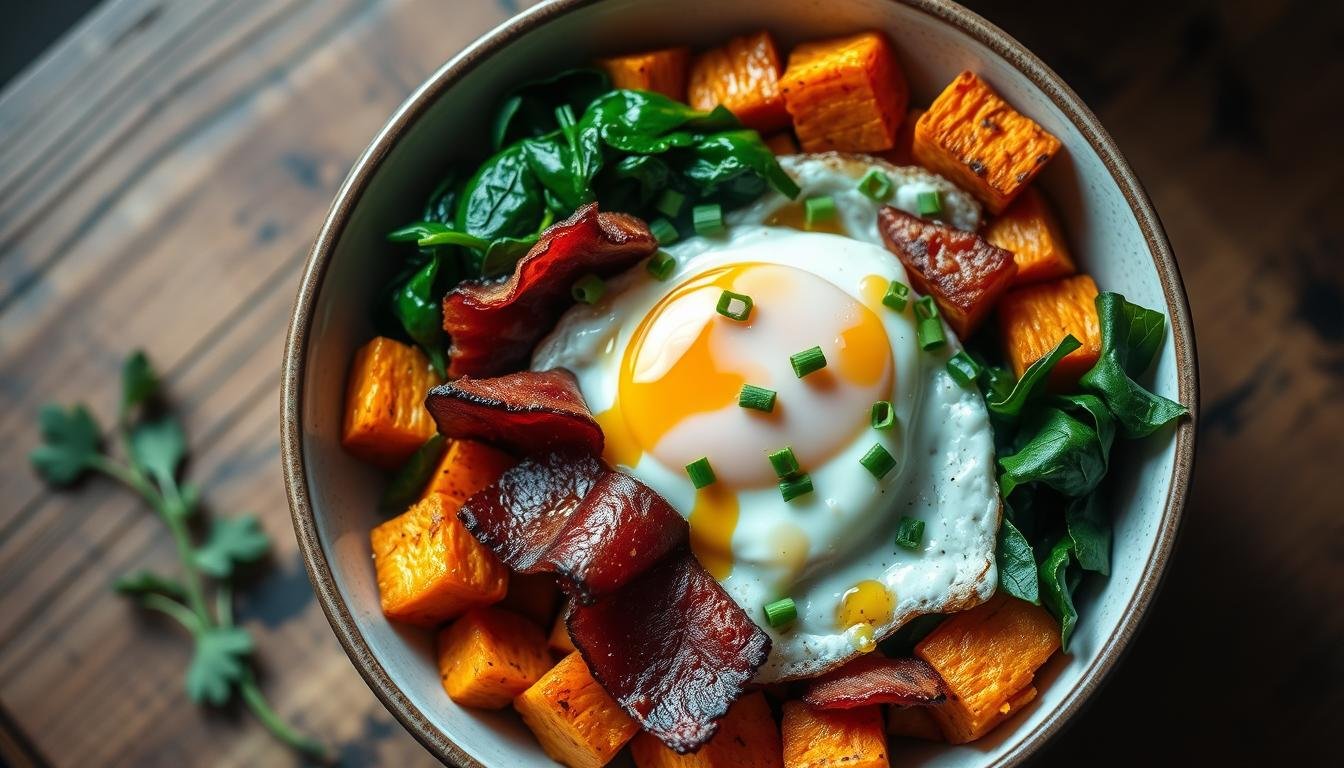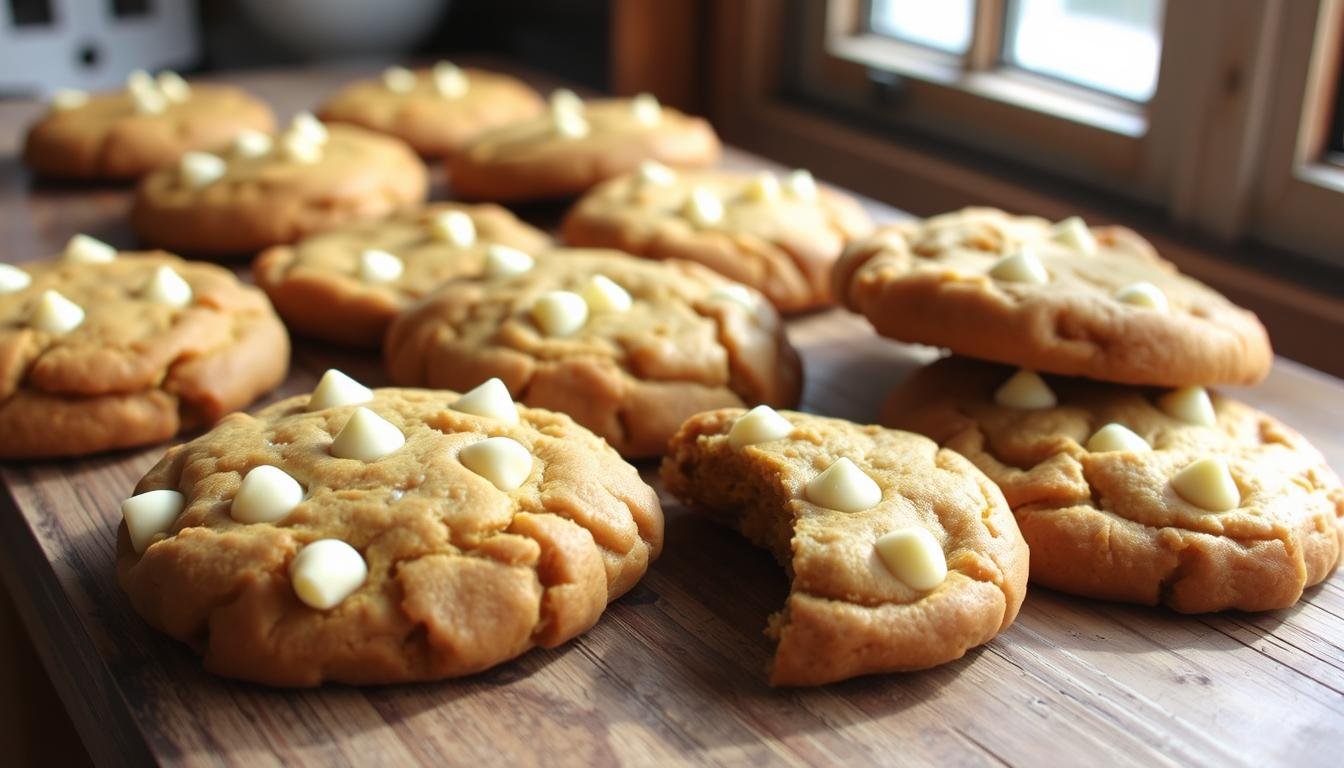Starting your day with golden pancakes, crispy bacon, or fluffy scrambled eggs is magical. These dishes fuel your body and ignite nostalgia. They set the tone for the day. In this guide, I’ll show you how to make iconic morning meals. You’ll get step-by-step photos to help in the kitchen.
From diner-style skillets to protein-packed options, each recipe is balanced. I’ve included calorie counts and ingredient swaps for different diets. Everyone deserves a morning energy boost.
These visually-driven recipes make cooking an adventure. Whether you’re meal-prepping or hosting guests, they’re crowd-pleasers. Let’s see how simple ingredients become classics, without needing a culinary degree.
Key Notes;
- Discover 10 iconic dishes representing U.S. morning food culture
- Use visual guides to master cooking techniques effortlessly
- Compare nutritional profiles to meet health goals
- Learn historical context behind portion sizes and ingredients
- Adapt recipes for quick weekday meals or leisurely brunches
Discover the Classic American Breakfast Menu With Pictures Experience
What makes a traditional American breakfast last in a world of new foods? I looked into history and today’s food trends. I found out why pancakes and scrambled eggs are beloved. They show us American values.
After World War II, our morning habits changed. Diners offered “All-Day Breakfast” menus for quick, affordable meals. New ways of making food, like pre-sliced bread, became popular. And studies showed the importance of protein in our meals.
Even with new foods like avocado toast, many Americans love bacon and eggs. They give us immediate energy from carbs and fats. This is good for both farm workers and office workers.
An American breakfast plate follows certain menu design principles:
- Centerpiece: Protein (eggs, sausage)
- Energy base: Carbs (toast, hash browns)
- Balance: Fresh fruit or juice
This layout is not just for looks. It follows old nutrition advice and lets different places add their own touches. Next time you see a diner menu, notice how it lets you choose what you like.
Today’s chefs keep the classics alive with new twists. They make gluten-free pancakes or use plant-based sausages. This shows that tradition can change without losing its heart. That’s why I love waffles with extra syrup—it’s a timeless choice.
1. Fluffy Buttermilk Pancakes
Buttermilk pancakes are a top choice for breakfast. They are fluffy and delicious. I tried IHOP’s secret and made a recipe that’s easy to make at home.
These pancakes are better than sugary cereals for breakfast. They give you energy and are easy to make.
The Ultimate Pancake Recipe
This 6-ingredient formula makes 12 pancakes in 20 minutes:
- Whisk 2 cups flour + 2 tsp baking powder + ½ tsp salt
- Mix 1¾ cups buttermilk + 1 egg + 3 tbsp melted butter
- Combine wet/dry ingredients – leave lumps for air pockets
- Rest batter 5 minutes while heating griddle to 375°F
- Cook ¼ cup portions until bubbles form (2 mins), then flip
Chef’s secret: Letting the batter rest makes the pancakes better. Use a cast iron pan for the best taste.
Why It Works: Carbohydrates & Morning Energy
Each serving has 58g complex carbs from flour and buttermilk. These carbs give you energy for hours:
- Provides 4+ hours of steady energy
- Supports brain function during morning tasks
- Pairs perfectly with protein toppings like peanut butter
The 7g protein per serving keeps you full. For a lighter option, use oat bran instead of flour.
Nutritional Profile: 380 Calories/Serving
| Nutrient | IHOP Version | Homemade |
|---|---|---|
| Calories | 490 | 380 |
| Carbs | 72g | 58g |
| Protein | 9g | 7g |
| Sodium | 1,420mg | 620mg |
My recipe has 23% less sodium. For a low-calorie version, use almond milk and lemon juice.
2. Protein-Packed Scrambled Eggs
Scrambled eggs are a breakfast favorite. But, when made right, they become a high-protein morning meal. This meal is great for both gym-goers and busy people.
Chef’s Technique for Creamy Eggs
The French continuous stirring method makes eggs creamy. Use low heat and a silicone spatula. Fold the eggs every 10 seconds for soft curds. This method keeps eggs soft and adds 6 grams of protein per large egg.
Muscle Recovery Benefits
Eggs have all nine essential amino acids. This makes them perfect for muscle recovery after working out. A three-egg scramble has 18g of protein, which is 40% of what you need for muscle repair. Add vitamin C-rich veggies like bell peppers to help iron absorption.
210 Calories + Cheese Add-On Options
The basic recipe (3 eggs cooked in butter) has 210 calories. For more protein without too many calories, try these cheese options:
| Cheese Type | Protein Boost | Calorie Impact |
|---|---|---|
| Feta Crumbles | +4g | +75 |
| Sharp Cheddar | +7g | +110 |
| Swiss Slice | +8g | +106 |
My top choice is nutritional yeast. It adds cheesy taste with 2g extra protein per tablespoon and only 20 calories.
3. Crispy Bacon Strips
No American breakfast is complete without bacon. It’s a favorite, but getting it just right is key. We’ll look at how to make it crispy and tasty, while keeping it healthy.
Oven vs Stovetop Methods
For perfect texture every time, choose your cooking method wisely:
- Oven-baked: Spread strips on a wire rack over a baking sheet. Cook at 400°F for 15-20 minutes. This method creates even crispness with minimal flipping.
- Stovetop: Use a cast-iron skillet on medium heat. Cook 4-6 minutes per side for traditional diner-style bacon. Requires more attention but delivers faster results.
I prefer the oven method when preparing bacon for a breakfast menu template – it handles larger batches effortlessly.
Moderation & Sodium Considerations
Bacon is tasty but high in sodium, with 190mg per slice. Here are some serving guidelines:
| Serving Size | Calories | Sodium |
|---|---|---|
| 1 slice | 43 | 190mg |
| 3 slices | 129 | 570mg |
Balance your plate with low-sodium items like fresh fruit or unsalted nuts. Crispiness doesn’t need extra salt – cooking technique brings out the flavor.
43 Calories/Slice + Pairing Ideas
Make bacon the star with these pairings:
- Sweet & salty: Wrap slices around Medjool dates
- Protein boost: Crumble over avocado toast
- Classic twist: Layer in breakfast sandwiches
Use bacon as a flavor accent in your breakfast menu template. Three slices add 12g protein without too many calories.
4. Golden Hash Browns
Golden hash browns are a classic “American breakfast” favorite. They’re crispy outside and soft inside, ready in under 20 minutes. I’ve found a double-cook method that makes them crunchy without deep-frying. This spud superstar is a must-try in your easy breakfast recipes.
Shredded Potato Mastery
To make hash browns that don’t stick together, follow these steps:
- Use russet potatoes (high starch, low moisture)
- Shred directly into ice water to prevent browning
- Squeeze shreds three times – once in a towel, twice in a salad spinner
My secret is par-cooking shredded potatoes in a skillet for 4 minutes. Then, chill them and recook. This makes a crisp lattice that stays crunchy, even with runny eggs.
Potassium & Digestive Fiber Benefits
A single cup of hash browns gives you 15% of your daily potassium. This is more than a medium banana. Potassium helps control blood pressure and muscle function. The resistant starch in cooled potatoes feeds gut bacteria and improves digestion.
250 Calories Per Cup Serving
Hash browns have only 250 calories per cooked cup. They’re great for most meal plans. To make them healthier, try:
- Mixing in shredded zucchini (adds vitamins, no flavor change)
- Using avocado oil spray instead of butter
- Topping with probiotic-rich Greek yogurt instead of sour cream
For a full easy breakfast, add scrambled eggs and a citrus wedge. The vitamin C helps your body absorb iron from potatoes.
5. Artisan Toast Variations
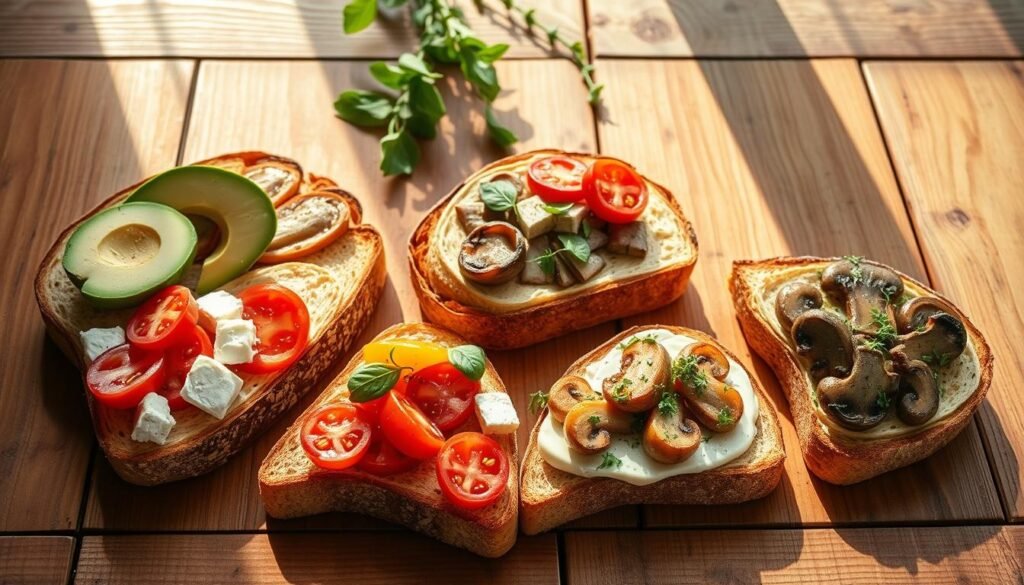
Toast has become a big deal in breakfast plate ideas. It’s now a canvas for endless flavors. Avocado toast is huge, with searches up 180% in cities last year. Let’s make simple bread into a healthy dish.
From Basic to Gourmet in 3 Steps
Begin with good bread like sourdough or rye. My top picks for making it better:
- Classic Butter & Jam: Try whipped honey butter + fresh jam
- Protein Power: Mix mashed white beans + olive oil + chili flakes
- Avocado Luxe: Add smashed Haas avocado + everything bagel seasoning + microgreens
Why Whole Grain Wins
Choosing multigrain bread adds a lot of fiber. A study found:
| Bread Type | Fiber (g) | Protein (g) | Calories |
|---|---|---|---|
| White | 1.2 | 3.5 | 150 |
| Multigrain | 4.8 | 6.2 | 180 |
Smart Calorie Management
Your toppings affect the calories:
“Avocado toast has about 280 calories. But, using smashed peas instead of cream cheese lowers it to 190.”
– Nutritionist Amanda Rhee
For lighter breakfast plate ideas, try ricotta with berries (210 cal) or almond butter with banana slices (240 cal). The key is finding the right mix of taste and health.
6. Maple-Infused Waffles
Maple-infused waffles are a perfect mix of tasty and healthy. They have a crisp golden crust and a light inside. This makes breakfast feel like a special treat.
Belgian-Style Batter Recipe
The secret is a yeast-based batter that ferments overnight. This makes the waffles have deep pockets. Always preheat your waffle iron for 10 minutes before cooking.
Here’s my fail-safe routine:
- Combine flour, yeast, and a pinch of cinnamon
- Whisk in warm milk and melted butter
- Let the batter rest 30 minutes for optimal rise
Complex Carb Fuel Source
These waffles use whole-grain flour. This gives you slow-release energy that lasts. They are better than sugary cereals because they don’t make you crash later.
420 Calories + Syrup Modifications
One waffle has 420 calories. To keep it healthy, try these syrup swaps:
| Syrup Type | Glycemic Index | Calories/Tbsp |
|---|---|---|
| Pure Maple | 54 | 52 |
| Sugar-Free | 10 | 15 |
| Berry Compote | 30 | 35 |
I like to drizzle almond butter on mine. It adds healthy fats and reduces sweetness. For a texture twist, add crushed walnuts between batter pours.
7. Farmer’s Breakfast Sausage
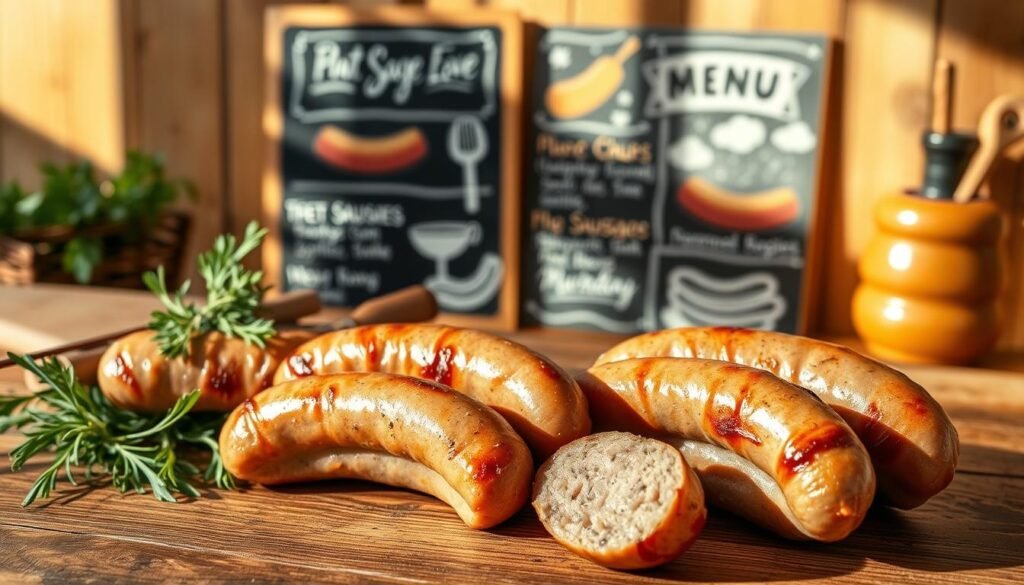
Savory sausage links on the griddle are a breakfast must. They add protein and can be used in many ways. This makes them perfect for both rustic and modern breakfasts.
Homemade vs Store-Bought
Making sausage at home lets you control the flavor and fat. My favorite mix includes:
- Fresh sage and thyme for earthy notes
- Maple syrup for subtle sweetness
- 75% lean pork shoulder for ideal texture
Store-bought sausages save time but might have preservatives. Choose brands with clean ingredient lists and fewer than 10 ingredients.
Iron Content & Protein Density
Each pork sausage link has 3.2mg iron (18% DV) and 14g protein. For plant-based diets, I use:
- Cooked lentils (6.6mg iron per cup)
- Pea protein isolate
- Blackstrap molasses as iron booster
This mix matches traditional sausage’s minerals but with less carbs.
180 Calories/Link + Vegetarian Alternatives
Pork sausage has 180 calories per link. It’s good for moderate-carb diets with:
- Egg whites
- Sautéed spinach
- Whole grain toast
For meat-free options, Field Roast’s apple-sage links (150 calories) or my lentil-walnut patties (170 calories) are great. They offer complete protein with grains and legumes.
8. Customizable Omelet Station
Customizable omelets are perfect for a personal breakfast. They suit everyone’s taste and dietary needs. Let’s explore how to make this breakfast menu idea a hit.
3-Egg Base Formula
Begin with three large eggs for a good mix of richness and size. Whisk them well with a bit of salt until they’re frothy. Use a nonstick pan on low-medium heat to avoid sticking issues.
My secret is not to flip the eggs. Pour them in, let them set for 90 seconds. Then, gently push the cooked edges towards the middle. This makes the omelet tender without flipping.
Vitamin D & Choline Benefits
Eggs are full of nutrients, including 41 IU of vitamin D per serving. This vitamin is great for bones and immune health, important in winter. The yolk also has 147 mg of choline, which helps your brain.
Studies show choline can keep your mind sharp as you get older. Add spinach or mushrooms to your omelet for extra benefits.
320 Calories + Cheese Impact
A basic three-egg omelet has 320 calories. Cheese changes both taste and nutrition. Here’s how different cheeses compare:
| Cheese Type | Calories Per Ounce | Protein Boost |
|---|---|---|
| Cheddar | 115 | 7g |
| Feta | 75 | 4g |
| Swiss | 111 | 8g |
For lighter breakfast menu ideas, use nutritional yeast or sharp cheeses. Melting cheeses like mozzarella add creaminess without too much salt.
9. Cold Cereal & Milk Combos
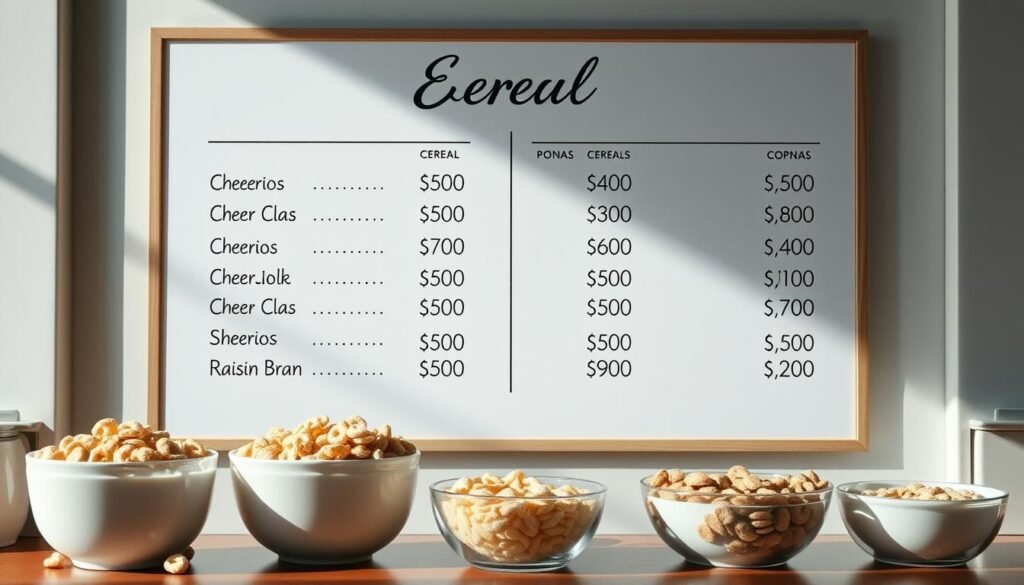
Nothing beats the crunch-and-pour simplicity of cereal for busy mornings. There are over 1,000 options in U.S. stores. I looked at top brands for nutrition, cost, and taste. Let’s find out which cereals are good for you and your wallet.
Nutritionist-Approved Picks
Registered dietitians suggest these low-sugar, high-fiber cereals:
- Cheerios (1g sugar, 3g fiber): $0.35/serving
- Kashi 7 Whole Grain Puffs (0g sugar, 4g fiber): $0.52/serving
- Special K Protein (9g protein, 5g sugar): $0.48/serving
“The best cereals have less than 5g added sugar and 3g fiber. Pair with low-fat milk for balanced nutrition.”
– American Dietetic Association Report
Calcium & Vitamin B12 Sources
Your cereal bowl becomes a nutrient powerhouse with dairy or fortified plant milks:
| Milk Type | Calcium (%DV) | B12 (%DV) |
|---|---|---|
| Whole Dairy | 30% | 50% |
| Almond Milk | 45% | 25% |
| Soy Milk | 30% | 50% |
150-400 Calorie Range Analysis
Calorie counts vary with portion size and add-ons:
- Basic Combo (1 cup cereal + skim milk): 150-220 calories
- Premium Mix (granola + whole milk + berries): 350-400 calories
For those watching their budget, store-brand cereals are a good choice. They often cost 20-30% less than name-brand cereals. Remember to use a kitchen scale to measure cereal. Most people pour too much!
10. Seasonal Fruit Platter
A vibrant fruit platter makes any breakfast menu pop. It adds natural sweetness and looks great. I choose fruits in season for the best taste and health.
Summer berries, autumn apples, winter citrus, and spring melons make for stunning displays. Arrange them with colors and heights that catch the eye. This look is inspired by the smoothie bowls that are big in 2024.
Artistry Meets Nutrition
Try layering kiwi and mango spirals on Greek yogurt for a tropical feel. Add pomegranate seeds or edible flowers for extra texture. Seasonal fruits like blueberries and peaches go well with pancakes, while grapefruit pairs with savory omelets.
Don’t forget to add a protein-rich dip like almond butter. It helps balance the natural sugars.
Smart Pairing Strategies
Use fruit platters as a refreshing contrast to richer foods like bacon or hash browns. Turn leftover fruits into morning smoothies. Use the “smoothie bowl” method—thick bases topped with granola and chia seeds.
This way, you reduce waste and boost fiber. Snap photos of your fruit platters and tag #MorningVibesChallenge. Share your plating ideas on Instagram. Try geometric cuts or rainbow gradients for a wow factor. Fresh fruit is more than a side dish—it’s a vibrant centerpiece that energizes and delights.

